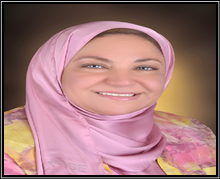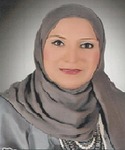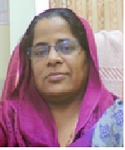Day 3 :
Keynote Forum
Amany M. Shebl
Mansoura University, Egypt
Keynote: The Impact of Application of Multimodal Approach on Expected Clinical Outcome for Post Illues Patients after Total Abdominal Hysterectomy
Time : 09:30-09:55

Biography:
Amany M Shebl has completed her PhD from Cairo University, Egypt. She occupied several positions as (Head of Medical-Surgical Nursing Department, Vice-dean for Student Affair, Vice-dean for Post Graduate and High Studies Research Affair). Now she is occupying position as Dean of Faculty of Nursing, Mansoura University, Egypt. She has several papers in reputed journals. She is also a Reviewer of International Cancer Journal and she is very interested in scientific research. Her mission is to guide highly qualified nurses & provide distinguished intellectual and professional insight in providing nursing care to meet the national and international market.
Abstract:
Background: Oral fluids and food are traditionally introduced slowly after total abdominal hysterectomy (TAH). This study examined the effect and tolerance of early oral intake following this surgery. Postoperative ileus (POI) is broadly defined as a temporary impairment of gastrointestinal (GI) motility, it leads to patient discomfort, decrease the mobility and prolongs both convalescence and hospital stay. rnrnAim: The aim of the study was to evaluate the impact of application of multimodal approach on expected clinical outcome for post ileus patients after total abdominal hysterectomy. rnrnDesign: Quasi-experimental design was used. The study was conducted in the Obstetrics and Gynecology Department in El-Minia General Hospital from first of September 2011 to the last of February 2012. rnrnSample: Total samples of 40 female patient divided equally into two groups (control group and intervention group) were assigned to multimodal approach. rnrnResults: The results also revealed that early feeding could be tolerated well in patients undergoing total abdominal hysterectomy TAH. Also the results show that with improvements in postoperative nausea and vomiting and length of stay were noted in the early fed group with minimal medical benefits. rnrnConclusion: This study concluded that early feeding and hydration after major gynecologic surgery results in decreased nausea and vomiting and decreased hospital stay, promote wound healing, optimizing patient condition before, during and after surgery and reduce the length of hospital stay. rnrnRecommendation: This study recommended that more approaches such as chewing gum, antiemetic drugs and laxatives should be applied to relieve the postoperative complications especially ileus after the total abdominal hysterectomy.
Keynote Forum
AboTaleb Saremi
Sarem Women’s Hospital, Tehran, Iran
Keynote: Usage, Development & Effectiveness of a New Surgical technique for the Treatment of Svere Adenomyosis
Time : 09:55-10:20

Biography:
Abo Taleb Saremi obtained his MD from Jondishapour and Tehran Universities, Iran in 1975. He was trained at the Obstetrics and Gynaecology Department of Munster University, Germany, took a subspecialty in IVF at Vienna University, Austria from 1981 to 1986 and then participated in complementary assisted reproduction courses in the USA and Australia. His specialization includes laparoscopic surgery and his work lead to the birth of the first Iranian assisted reproduction child (by gamete intra-Fallopian transfer) in 1989. He founded his first IVF centre in Iran in 1993 and received the International Federation of Fertility Societies’ 30th anniversary recognition award in 1998. He is the President of the Sarem Women’s Hospital, which he founded in 2006, and the Sarem Cell Research Center.
Abstract:
Advised treatment of the severe forms of adenomyosis is hysterectomy but for the patients those who want to preserve their uterus, conservative surgery named adenomyomectomy for removal of endometrial tissue from the myometrium can be performed. This technique must be developed for reduction of the spontaneous uterine rupture, adhesions and recurrence rate. So, this study is to investigate the safety and therapeutic outcomes of different and novel adenomyomectomy technique. Prospectively, 103 Iranian patients with documented severe adenomyosis were candidates for adenomyomectomy over a period of 7 years (April 2004-March 2011). The surgical procedure is the resection of adenomatous lesions with the thin (0.5 cm) margin, wedge shaped in two sides of the uterus wall, with sagittal incision on the body of the uterine and reconstruction of the layers and inverted suture for the serosa layer ends. Out of 103 patients, 57 cases (55.34%) were presented with infertility, 17 cases (16.5%) with IVF failure, 9 cases (8.74%) with recurrent abortion and 20 cases (19.42%) with abnormal vaginal bleeding (AUB). Out of 70 patients that wish to bear child, 21 persons (30%) became pregnant spontaneously (7 cases) or by ART technique (14 cases) and 16 pregnancies became full term and candidates for cesarean section (C/S). There was a significant reduction in both dysmenorrhoea and hypermenorrhoea. Only one case had relapsed adenomyosis. Adenomyomectomy is the conservative and effective option on treatment of adenomyosis. The described procedure in this study can be an efficient procedure for the treatment of severe adenomyosis.
- Midwifery , Maternal Fetal medicine, Urogynecology , Gynecological Endocrinology, Gynecological Oncology
Location: Hall TX -C

Chair
Mouhanad Hammami
Chief of Health Operations and Human Services, USA

Co-Chair
Katie Moriarty
Wayne County Health Authority, USA
Session Introduction
Louisa M Tsweleng
University of Venda
Title: The culture of midwifery, as experienced by midwives in their practice during labour.
Biography:
Tsweleng M. L is curently working as Lecturer in Department of Advanced Nursing Science, University of Venda, South Africa. She is registered as a Ph.D. student at the University of Venda, South Africa in 2011, Doctoral research methodology, University of Johannesburg. She completed Mcur (Advanced Midwifery and Neonatal Nursing Science) from University of Johannesburg from 2001-2004 and Bcur I E (Nursing education and Administration), University of Pretoria from 1996-1998. She presented papers nationally and internationally and some publications are still under process.
Abstract:
Background Midwives and the care they provide to women, babies and families are most valuable to countries of the world. In South Africa midwives are key professionals in ensuring that women have a safe and a positive experience during their pregnancy, childbirth and postnatal period. Little is known about, the experience of midwives regarding, the culture of midwifery, in their practice Objective This study was designed to explore and describe the culture of midwifery, as experienced by midwives, when providing care to women during labour Methods A qualitative phenomenological design was used. Participants purposively selected in the labour ward of a midwife obstetric unit, in the semi-rural area in the far northern part of Pretoria, Gauteng province, South Africa.Individual-indepth interviews conducted with a semi –structured tool. Data analysed, using interpretative phenomenology. Findings Themes with the detailed description of the experience of midwives regarding the culture of midwifery in their practice during labour, emerged from the findings. Conclusions The findings highlighted the impact of the culture of midwifery in the practice of midwives during labour, a perceived by midwives. This will help to improve and better the practice and inform research
Luis Henrique
School of Nursing, York University
Title: The humanization of birth: the experience of Brazilian women
Biography:
Luis Henrique working at School of Nursing, York University.
Abstract:
Objectives The present study aims to explore the Brazilian child birthing experience, and identify how the puerperal woman experiences her pregnancy and birth in the humanized model of care. Methods A quali-quantitative research design was used to achieve the goals of the study by recruiting eighty individuals, after the birth process, in a maternity centre at a public hospital in Sao Paulo, Brazil. Data was collected through observation, semistructured interviews, and then a qualitative content analysis was performed. Results Among the individuals: 64% of them attended 8 to 10 consultations, and related more positive feelings to having a baby, showing a clear relation between attending to prenatal consultations and describing the birth as a positive experience; 85% of them used the benefit of having a birth companion, and it was described as reassuring. Conversely, those who experienced a more than six hours labour related the process as very painful. Nurses are the professionals most involved with the process, and their service was rated as very good by 53,8% and good by 43,8% of the responders. Conclusions The humanized birth is a long term process that starts during the prenatal period. Women well accept the process and consider it as beneficial, but when the labour takes long the most remarkable feeling is the pain. The birth process was considered as a remarkable life point as well as an event that brings great responsibility to the women's lives. Being the nurse the most involved professional, they have earned respect and admiration of postpartum women.
Michael Kleerekoper
University of toledo ,USA
Title: THE AGING HUMAN SKELETON: A BRIDGE TO NOWHERE?
Time : 9:30 -9:50

Biography:
Michael Kleerekoper, MD, MACE, has joined the faculty at the University of Toledo Medical School where he is a Professor in the Department of Internal Medicine and section chief of the Endocrinology Division. He is also the author of numerous journal studies, Kleerekoper serves on the editorial boards for Endocrine Today, Endocrine Practice, Journal of Clinical Densitometry, Journal of Women's Health, Osteoporosis International and Calcified Tissue International. Dr. Kleerekoper is also a founding board member of the newly formed Academy of Women’s Health.
Abstract:
Abstract : Osteoporosis is more common in postmenopausal women than in men of similar age. In those women who are not treated for menopause are more likely to develop bone loss and an increase in minimal trauma fractures. The current recommendations are that bone mineral density (BMD) should not be assessed before age 65 but one or two programs recommend an age 60 for the first Dual Energy X-ray Absorptiometry (DXA). Women who have additional post-menopause medical conditions and/or medications may have increased risk of minimal trauma fractures before age 60. DXA studies should be accompanied by laboratory studies that include serum calcium, serum creatinine, and 25 hydroxyvitamin D, as well 24 hour urine collection for calcium, creatinine, sodium, uric acid, and oxalate. Management is dependent on the bone density and biochemistry. The biochemistry includes markers of bone resorption i.e., C-terminal telopeptide of type 1 collagen (CTX), and bone formation i.e., bone alkaline phosphatase (B-ALP), C-terminal propeptide of type 1 procollagen (P1CP) and N-terminal propeptide of type 1 procollagen (P1NP). Regrettably the majority of DXA studies are performed and reported by bone density technicians and clinicians who have not been appropriately trained in the conduct and reporting of DXA and therapy is often incorrect. Once diagnosed as osteoporosis, there are several anti-resorption products that have been approved by the FDA or are in progress and teriparatide has been approved for stimulation of bone formation. Once a diagnosis of osteoporosis and appropriate therapy has been established, measurement of biochemical markers should be obtained at 6 monthly intervals until the levels are stable. If bone density is stable for five years, the therapy can be discontinued and biochemistry analyzed at 6-12 monthly intervals. More recent studies in progress include high resolution measurement of the distal radius and tibia using either high resolution Magnetic Imaging (hrMRI) or high resolution Dual energy X-ray Absorptiometry (hrDXA). hrDXA is also being study in the spine and proximal femur. These studies provide improved evaluation of skeletal health. Details of the above aspects of skeletal studies are shown in the accompanying illustrations and images.
Tatek Abate
Ethiopian Midwives Association, Ethopia
Title: To Assess Birth Outcome and Prevalence of Postpartum Morbidity Among Women
Time : 9:50 - 10:10

Biography:
Tatek Abate Zewdie present working at Ethiopian Midwives Association as Executive Director , With this position I am in charge for the overall leadership, management, representation of the association at national, regional and international level. In addition I am responsible in leading and coordinating the different units and programs in the association.
Abstract:
Abstract Introduction: In Ethiopia, an estimated 676 maternal deaths occur for every 100,000 live births. The major causes of mortality and morbidity are direct obstetric causes; they mainly occur from the third trimester of pregnancy to the first week following delivery. This study elucidates the type, magnitude and associated factors of postpartum morbidity conditions among pregnant women who gave birth at the health institutions and is essential to understand the health care need for obstetric emergencies, postpartum conditions and to prepare health organizations to better monitoring and evaluation of safe motherhood programs. Objective: To assess birth outcome and prevalence of postpartum morbidity among women attending antenatal care and gave birth at health institutions in Gondar town. Methods: We have conducted a four-month follow up study among 203 randomly selected pregnant women from five health institutions in Gondar town. Data were collected between March 1, 2010 and June 30, 2010 through interviews and physical examinations at four follow up visits: antenatal care, labor and delivery, 12th and 42nd postpartum days. We have used Epi Info 2002 for data entry and SPSS for data analysis. Results: A total of 203 (89.04%) pregnant women completed the four follow up visits and were included in the analysis. Postpartum morbidity conditions were found among 48 (23.6%) mothers, of whom 12 (5.9%) mothers had suffered two or more morbidity conditions. Overall, morbidity from postpartum hemorrhage had the highest prevalence 30 (14.8%) followed by sepsis and anemia. Intra-partum deviations were the main contributing factors to the postpartum morbidity conditions (AOR=4.148, P=0.027). There were 5(2.5%) still births and 38(18.7%) low birth weights. Conclusion and recommendation: The occurrence of postpartum morbidity, low birth and still birth among pregnant women attending & giving birth at health institution in Gondar town was significant health concern. Intrapartum abnormalities were the main predictive factors triggering maternal morbidity conditions. The time from birth to the first 6 hrs of purperum was the peak time to postpartom hemorrhage. Therefore, interventions such as universal use of the partograpgh, active third stage management and encouraging all delivering women to stay in the health institution during the first 24 hours of delivery could play a key role in reducing postpartum morbidity.
Noreen Zafar
Girls and Women Health Initiative, Pakistan
Title: Incidence of Pap smear based cytological abnormalities in a low risk group of Pakistani women
Time : 10:10 - 10:30

Biography:
Dr Noreen Zafar holds FRCOG from the Royal College of Obstetricians and Gynaecologists, London .She is the first Pakistani practitioner to be granted The Certificate of Completion of Specialist Training from the Joint Committee of Medical Royal Colleges, UK. Presently working as Consultant Obstetrician and Gynaecologist in Pakistan . Dr Zafar was honored with “National Women Award” for recognition of extra – ordinary services in the field of girls and women health on 4th August 2007 in Lahore.She was awarded the first International Individual Achievement John Eisenberg Award by the Joint Commission and The National Quality Forum , USA , in Oct 2009 in recognition of her extra ordinary services to the cause of girls and women's health in Pakistan. She was given the 'The Woman Of Excellence Award ' by Barclays Bank PLC in March 2011. Dr Zafar is the Founder and President of Girls & Women Health Initiative (GWHI, www.gwhi.org) , a not for profit, charitable venture, conceived to materialize the dream of empowering girls and women to take charge of their health and well being. (GWHI) is designed to reach out to the under privileged and poor population of girls and women. An important agenda is to de-myth gynaecology as a shameful topic, banned for discussions .
Abstract:
Cervical cancer is the second most common cancer among women worldwide, with 80% cases in the in developing countries. In Pakistan it is not considered to be a huge problem. This study was carried out to ascertain the incidence of abnormal Pap smears among Pakistani women, to objectively justify the need for a cervical cancer screening program in Pakistan. 525 patient case notes attending gynaecology out patients over 18 month’s period were reviewed. Spatula and cytobrush samples were taken for all post menopausal women and in those where squamo-columnar junction was not visible. All patients with HSIL & ASC-H underwent colposcopy & biopsy. Endometrial sampling was performed if indicated Results Negative for intraepithelial lesions, 56 % Inflammatory in 25.33 % Atrophic in 4 % Inadequate 1.33% Cytological abnormalities were present in -13.34 %. The incidence of cytological abnormalities among Pakistani women is significant .The progression of HSIL to invasive disease is well documented .This study highlights the urgent need for a national cervical pre-cancer screening program in Pakistan.
Suzan E. Mansour
Mansoura University, Egypt
Title: The Effect of Dysmenorrhea on Quality of Life of Technical Secondary Schools Girls
Time : 10:30 - 10:50

Biography:
Suzan Elsaid Mansour, an Egyptian Academic Staff is working a Lecturer at Faculty of Nursing at El-mansoura University. She is specialized in woman's health and midwifery nursing. She is also Lecturer at Faculty of Nursing, British University. She acts as a Manager of Education Development Center, Faculty of Nursing, Mansoura University. She has published several papers in national and international journals. In addition to her teaching responsibilities, she is a member in quality and accreditation committee and member of Mansoura University Laboratory Committee. She is a Manager for the Specialized Nursing Program of Technical Nursing Institution, Mansoura University. She also acts as Reviewer of International Journal of Medical and Health Science Research. She has experience in teaching undergraduate and post graduate students. She is interested in scientific research especially topics related to evidence based and quality of nursing care. Her ongoing mission is to develop nursing and to provide the highest quality nursing care to achieve excellence in patient results, and her role is to facilitate and deliver educational opportunities and experiences to all students.
Abstract:
Abstract Sexuality is an important part of normal human functioning. Gynecological cancer diagnosis and treatment has devastating effect on sexual issues. The study aim was to investigate oncology nurses’ knowledge and attitudes in relation to provision of sexual health care to women diagnosed with gynecological cancer. The study setting was conducted at oncology center, at Mansoura University Hospital after obtaining Hospital Director’s approval. A subject which consisted of 72 nurses who worked in Gynecological Oncology Department was considered for the study. Four tools were used by the researchers to collect pertinent data. (1) The Self-Administered Structured Schedule, (2) Sexual Health Care Scale–Attitude, (3) Facilitators about sexuality issue discussion in nursing practice, and (4) Barriers about sexuality issue discussion in nursing practice. Results revealed that 100% of nurses were having poor knowledge score regarding sexual health care with mean score 7.3±2.5. There was statistically significant relation between knowledge score and discomfort in providing sexual health care and fear of college’s negative response (P<0.05) while there was no statistical significant relation between knowledge score and feeling uncertain about patient’s acceptance and lack of environmental support (P>0.05). Majority of nurses reported that limited resources, patient embarrassment, staff shortages, patients having more things to be concerned about than having sex, inadequate education preparation, are the most important barriers to provide health sexual education. Provisions of relevant training, availability of private environment, having good nurse patient relationship, good communication are factors which facilitate provision of sexual health care. It was concluded that oncology nurses have poor knowledge score and a feeling of discomfort in the provision of sexual health care. There are many issues acting as barriers and facilitators affecting nurses for providing sexual health care. It is important to put sexual health education into the curriculum of nursing, in order to assess the sexual health of patients within the health care system, continuing education activities and availability of education materials could assist nurses to adequately address sexual concerns while caring for patients with cancer and more research is needed on training of the nurses to overcome the barriers and guidelines or procedures in place for dealing with sexuality-related issues with patients.
M.KAAVYA
Sree Balaji Medical College and Hospital, India
Title: PERIPARTUM CARDIOMYOPATHY-A CASE REPORT
Time : 10:50 - 11:10

Biography:
M Kaavya is in her second year Post-graduation in Obstetrics & Gynecology in Sree Balaji Medical College, Chennai, India. She has presented a paper in IMSACON 2014 (International Conference) held in Bangkok, (Thailand). Her paper focused on “Previous uterine scar on present placental location”.
Abstract:
Abstract Background: Peripartum cardiomyopathy is an unusual form of dilated cardiomyopathy with unknown etiology, that can be fatal in young women but with prompt diagnosis and intensive supportive measures can successfully be treated with good long term prognosis in 90% cases. We report a previously asymptomatic women with no risk factor presented with pulmonary odema on day three of cesarean section who is now under periodic ECHO follow up to assess the recovery in cardiac function. Case Report: 28 years old primigravida married for two years, GDM on meal plan underwent cesarean section at 40 weeks for fetal distress. Intrapartum and initial postpartum period were uneventful. On third postoperative day, patient developed acute breathlessness with bilateral extensive basal crepts. ECHO picture suggested peripartum cardiomyopathy. Patient shifted to ICU and treated with respiratory support, inotropes, diuretics and other supportive measures. Patient was symptomatically better on fifth postoperative day and discharged at request on fourteenth postoperative day explaining the need for regular follow up and the high risk of recurrence of peripartum cardiomyopathy in subsequent pregnancies. Discussion: Though peripartum cardiomyopathy is relatively a rare disease (0.1% of pregnancies) it can lead to devasting consequences with overall morbidity mortality rates as high as 5 to 32%.The diagnosis of peripartum cardiomyopathy is challenging since most women in last month of normal pregnancy or soon after delivery experience dyspnoae, fatigue and pedal odema,(as in our case). Hence the treating physician should have high index of suspicion and consider it when managing dyspneic patients to expedite medical treatment for this potentially lethal condition.
Abinaya Vijayan
Sree Balaji Medical College and Hospital, India
Title: Careful Diagnosis and Management of Monochorionic Monoamniotic twins
Time : 11:10 - 11:30

Biography:
Abinaya Vijayan is doing her final year Post-graduation in Obstetrics and Gynaecology (MS) at Sree Balaji Medical College & Hospital, Chennai, Tamilnadu, India. She has presented a paper in International Conference IMSACON.
Abstract:
Abstract Monochorionic monoamniotic twins are subtype of monozygotic twin pregnancy. These twins are rare, occurring in approximately 1 in 35,000 to 1 in 60,000 pregnancies. These twins are associated with increased morbidity and mortality. Hence with early diagnosis of chorionicity and amnionicity and its associated complications, the rate of fetal loss can be reduced. Intensified antenatal monitoring is required from 1st trimester onwards. We report a case of second gravida with previous normal vaginal delivery with monochorionic monoamniotic twin pregnancy. She was diagnosed at 11 weeks gestation by ultrasound. From then she was monitored extensively and was allowed for spontaneous onset of labour at 37 weeks. She delivered two alive babies with good APGAR score. With careful monitoriong throughout pregnancy, good prognosis and outcome can be achieved.
Mohammad Othman
University of Liverpool, UK
Title: Probiotics for the prevention of preterm labour
Time : 11:30 - 11:50

Biography:
Mohammad Othman has completed his PhD from University of Liverpool. He is Assistant Professor of Obstetrics and Gynecology in University of Al-Baha Medical College. He has published three books and more than 25 papers in reputed journals and has been serving as an editor and referee of more than 32 medical publications and databases.
Abstract:
Abstract Preterm birth causes 60% to 80% of neonatal deaths. Survivors can experience life-long complications. Thirty to fifty per cent of preterm labours are associated with maternal infection. Probiotics are defined as live micro-organisms which in adequate amount confer a health benefit on the host. They have been shown to displace and kill pathogens and modulate the immune response, thus potentially interfering with the inflammatory cascade that leads to preterm labour and delivery. During pregnancy, local treatment which restores normal vaginal flora and acidity without systemic effects is preferred over other treatments to prevent preterm labour. The objective is to evaluate the effectiveness and the safety of probiotics for preventing preterm labour and birth. We assessed seven trials for inclusion in the review and included three trials. Effects on very preterm birth (risk ratio (RR) 0.65; 95% confidence interval (CI) 0.03 to 15.88) and preterm birth (less than 37 weeks) (RR 3.95; 95% CI 0.36 to 42.91) showed very wide CIs and no effect of statistical significance (one trial; 238 women). Effects on neonatal death or severe morbidity were not estimable. The impact of probiotics on vaginal infection was based on only 88 women in two trials. There was an 81% reduction in the risk of genital infection with the use of probiotics (RR 0.19; 95% CI 0.08 to 0.48). Although the use of probiotics appears to treat vaginal infections in pregnancy, there are currently insufficient data from trials to demonstrate any impact on preterm birth and its complications.
S Nafees Bano
HSZH ,Govt. Unani Medical College, INDIA
Title: Treatment of uterine leiomyoma with sal ammoniac: A single-blind randomized placebo controlled study
Time : 11:50 - 12:10

Biography:
Dr. S. Nafees Bano is a Professor in the Department of Obstetrics and Gynecology, Hakim Syed Ziaul Hasan Govt. Unani Medical College & Hospital, Barkatullah University, Bhopal, M.P. She graduated from Hamdard Tibbi College, Delhi University in 1990 and started giving her services as a gynecologist. She started her academic career in 1995 and has been giving her services in various Unani Medical Colleges and Hospitals. She received her M.D. in 2008 from National Institute of Unani Medicine, RGUHS, Karnataka. In her 20- year long career she has been giving her services as Examiner in various Universities, Supervisor for M.D. theses, Subject Expert in various Selection Boards & MPPSC, Resource Person, Guest Speaker, Chairperson in Workshops, Training Programmes and Seminars & is the Chairman, Board of Studies, Barkatullah University, Bhopal. She has presented papers in various Conferences and Seminars and delivered a talk on women health issues on All India Radio, Bhopal. She is also the Chairman, IEC, CCRUM, Bhopal for the current year.
Abstract:
Abstract Introduction: Uterine leiomyoma is the commonest tumour found in women. It constitutes a major public health cost to the community in terms of outpatient attendances and hospital costs for surgery of the disease. Objective: Women are seeking alternatives to conventional medications and surgery for the treatment of leiomyoma. Therefore, it is important to test whether Sal Ammoniac is efficacious and safe in the management of leiomyoma. Design: Randomized single-blind placebo controlled trial is designed. Setting: Outpatient Department, National Institute of Unani Medicine Hospital, Bangalore. Population: 40 patients with diagnosed uterine leiomyoma. Methods: Randomization to either 2 gm sal ammoniac with 5 ml glycerin twice (N=25) daily or placebo (N=15) twice daily for 12 weeks from inclusion. This was a USG based study. Assessment of menorrhagia was done by the patient and assessment of dysmenorrhoea was done by pain rating scale. The impact of leiomyoma related symptoms on quality of life (QOL) was assessed by using a validated questionnaire. Results: There was significant improvement in menorrhagia and dysmenorrhoea. Mean leiomyoma size decreased by 18% at 45 days and 35.19% at 90 days of Sal Ammoniac therapy. Patients treated with placebo had an increase in mean leiomyoma size of 33% at 90 days follow up. No side effects or adverse were reported with the drug. A significant improvement in the symptom score and QOL score was observed at 90 days follow up. Conclusion: In this study, Sal Ammoniac successfully reduced the size and symptoms of leiomyoma in short-term follow up. Additional studies are needed before its efficacy and safety can be confirmed.
Ariel Polonsky
"Laniado" medical center, Netanya, Israel.
Title: Viable triplet pregnancy coexisting with a complete molar pregnancy
Time : 12:10 - 12:30
Biography:
Ariel Polonsky working as a resident at Laniado medical center, Netanya, Israel.
Abstract:
Abstract Gestational trophoblastic disease is a proliferative disorder of trophoblastic cells. In our case an 11 weeks pregnant patient who turned up for medical evaluation due to mild vaginal bleeding and diarrhea, was diagnosed with triplet viable fetuses along with a complete molar pregnancy after a cycle of timed intercourse and clomiphene citrate stimulation. The risks of a singleton molar pregnancy are well known and include: Severe vaginal bleeding, hyperthyroidism and thyroid storm, early onset preeclampsia and hysterectomy. In addition, persistent trophoblastic disease and chemotherapeutic treatment is also a known risk even after evacuation of the pregnancy. The incidence of these same risks, increase dramatically with every additional fetus alongside the mole. After literature review and from our experience we assumed a higher theoretical risk for pregnancy complications and PTD for our patient. Keywords: triplet pregnancy, molar pregnancy, artificial reproductive technology Abbreviations: Gestational trophoblastic disease (GTD), Persistent trophoblastic disease (PTD), Human chorionic gonadotropic (hCG), Termination of pregnancy (TOP), Maternal fetal medicine (MFM), international units (IU).
B Saranya
Sree Balaji Medical College & Hospital, India
Title: Clinical presentation of ectopic pregnancy presented as PID – A case report
Time : 12:30 - 12:50

Biography:
B Saranya is doing her first year post-graduation in Obstetrics and Gynecology at Sree Balaji Medical College & Hospital, Chennai, Tamil Nadu, India.
Abstract:
Abstract Ectopic pregnancy, also known as eccyesis or tubal pregnancy, is a complication of pregnancy in which the embryo attaches outside the uterus (the cervix, ovaries, or within the abdomen). Clinical trial of ectopic pregnancy is abdominal pain, vaginal bleeding and a period of amenorrhoea. Detection of ectopic pregnancy is typically by blood tests for human chorionic gonadotropin (hCG) and ultrasound. A success in the management of ectopic pregnancy lies in the prompt diagnosis and proper management. Some ectopic pregnancy may present without a period of amenorrhoea, which warrants high index of suspicion. Here, we report a case of 27 year old patient with a case of ruptured ectopic pregnancy presented with abdominal pain and spotting PV without a period of amenorrhoea. Her ultrasound was suggestive of pelvic inflammatory disease, Beta HCG - 6725mIu/ ml and UPT is negative. Patient was taken up for diagnostic laparoscopy & proceeded with left salphingectomy.
K Sofia Mercy
Sree Balaji Medical College & Hospital, India
Title: Incarcerated vaginal pessary- A report of two cases
Time : 12:50 - 1:10

Biography:
K Sofia Mercy is in her final year Post-graduation in Obstetrics and Gynecology (MS) at Sree Balaji Medical College & Hospital, Chennai, Tamilnadu, India. She has presented a paper in AICOG 2015.
Abstract:
Abstract Background: Vaginal pessaries have been offered as a first line of treatment for symptomatic prolapse in women not willing for surgery, not fit for surgical interventions and young women who wish to postpone surgery. We report two cases of partially incarcerated vaginal pessary. Case Report 1: 68 years P8L7A1 diabetic on treatment presented with complaints of supra pubic pain and Dysuria. She is a known case of pelvic organ prolapse for which vaginal pessary was inserted 2 years back at sirkazhi, with instructions for follow up every 3 months. She had no difficulties with the pessary, so she did not turn for follow up. Case Report 2: 75 years old P6L4D3A1 hypertensive on treatment, known to have a case of pelvic organ prolapse for 10 years, presented to the OPD for her routine 3 monthly pessary review with no complaints. Local examination of both the cases showed displaced vaginal pessary, first case embedded in the posterior vaginal wall and the second case in the lateral vaginal wall with a 2 cm band of vaginal epithelium between two entry points. Both cases pessaries were removed under IV sedation by cutting the ring pessary with scalpel. Discussion: Incarcerated vaginal pessary is the one which is displaced from its original position and becomes embedded in the vaginal or cervical mucosa. Complications with ring pessaries are vaginal bleeding, discharge, voiding and defecating dysfunction. Neglected pessary if left in situ for years, may erode into the rectum or bladder causing rectovaginal or vesicovaginal fistula. Early vaginal ring pessary entrapment may be related to the type of pessary material, concomitant vaginal atrophy, and inherent local tissue reaction in response to chronic vaginal irritation. All patients should be educated about self-care and the significance of strictly timed follow-up visits.
- Genitourinary Medicine, Sexual Medicine Novel approaches in genitourinary malignancies, Reproductive Medicine, Prenatal Diagnosis
Location: Texas C

Chair
Michael Kleerekoper
University of Toledo, USA

Co-Chair
Suzan E. Mansour
Mansoura University, Egypt
Session Introduction
Katie Moriarty
Wayne County Health Authority, USA
Title: Pregnancy and How we Birth: Why these matter
Time : 11:00-11:25

Biography:
Dr. Katie Moriarty, PhD, CNM, CAFCI, FACNM, RN is on faculty at Frontier Nursing University and a Certified Nurse-Midwife with the Wayne State University Physician Group CNM Service at Hutzel Women’s Hospital in Detroit, Michigan. Katie serves on the Board of Directors for the American College of Nurse-Midwives as the Region IV Representative. Dr. Moriarty was previously the Associate Director of the Nurse-Midwifery Education Program at the University of Michigan and launched the first Integrative Healthcare and Complementary Therapies Clinic in Pregnancy and Reproductive Women’s Health at the UofM Nurse Managed Center Clinic. Dr. Moriarty earned her BScN at the University of Windsor, Ontario CANADA; MS (Perinatal Nursing and Nurse-Midwifery) and PhD from the University of Illinois at Chicago.
Abstract:
The total amount spent on health care in the USA is greater than any other country in the world yet we rank poorly in international standings with regard to infant mortality. Despite the existence of high quality, nationally recognized health systems in metropolitan Detroit, the appalling rates of death and racial health disparities among the most vulnerable members of our community, infants, and the maternal mortality rate for African American women rival that of third-world countries. The reasons behind these disparate maternal and infant health outcomes in Detroit are complex. Social and economic conditions are intrinsically linked with health and research examining the life-course conceptual model of racial disparity has demonstrated adverse birth outcomes from these effects of stress. As well, there is a lack of support of physiologic childbirth which is the innate, hormonally driven processes that have developed through human evolution to facilitate the period from the onset of labor through birth of the baby along with skin to skin contact and the establishment of breastfeeding. The lack of these critical elements may have long term population health consequences. For the nation we need to address how we give care during pregnancy and how we actually are born. Exemplars of models of care and the mounting research on how we are born with its impact on outcomes will be presented. Strategies on how to support the normal physiologic processes of labor and birth, even in the presence of complications, to enhance both maternal and infant outcomes will be presented.
Elliot M. Levine
Illinois Masonic Medical Center, USA
Title: Risk Stratification and Prophylaxis of Venous Thromboembolic Events in Obstetrics
Time : 11:25-11:45

Biography:
Dr. Elliot M. Levine received his Bachelor of Science from the University of Wisconsin at Madison in 1974 and his MD from the Chicago Medical School in 1978 and completed his Residency in Obstetrics and Gynecology at Illinois Masonic Medical Center in 1982. He has been Board Certified in Obstetrics & Gynecology continuously since 1984. He is a member of a number of medical societies including the American College of Obstetricians and Gynecologists, the Chicago Gynecological Society, the Central Association of Obstetricians and Gynecologists, and the American Medical Informatics Association, to name a few. His involvement in research, education and Quality Assurance has allowed him to author numerous articles in medical journals, leading him to often lecture to physician audiences. He has served as Director of Informatics and Research in a Department of Obstetrics & Gynecology for well over a decade and as a Physician Director for the implementation of an Electronic Medical Record System in a large healthcare system. He continues to have a general gynecology practice, and has been listed in America’s Top Doctors for over a decade.
Abstract:
Objective: To identify the risk factors for perioperative venous thromboembolism, and the possible consequences of chemical thromboprophylaxis used with cesarean delivery. Study Design: An Enterprise Data Warehouse (EDW) of a multi-hospital system was queried to obtain the incidence of and risk factors for perioperative venous thromboembolism (VTE) and the use of chemical thromboprophylaxis (CTP). Results: Of 337,174 surgical patients over the course of 2010-2013, Cesarean Delivery (CD) occurred 24,608 times, with chemical VTE prophylaxis being provided 931 times and 23,677 times without such prophylaxis. CTP was provided a total of less than 4% of the time. Hemorrhagic complications were recorded 0.08% of the time (0.2% when CTP was provided, and 0.07% without it). Though this was not found to be a statistically significant difference (p = .13), it may still warrant our concern, regarding the appropriateness of using CTP for all cesarean deliveries. Conclusion: Chemical thromboprophylaxis may have the risk of associated hemorrhage with its use, and it may be worthwhile to use risk stratification to decide whether or not to use it for surgical prophylaxis in particular cesarean cases.
Nahed F. Khedr
Mansoura University, Egypt
Title: Minimize Peripheral Edema for Healthy Pregnant Women in Third Trimester by Water Immersion
Time : 14:45-15:05

Biography:
Nahid Fikry Khedr has completed her Doctoral education from Ain Shams University, Egypt. She is Assistant Professor of Woman's Health Nursing and Midwifery. She is the Head of Woman’s Health Nursing and Midwifery Department, Faculty of Nursing, Mansoura University, Egypt. She has several papers in reputed journals and is a member in several faculty committees. She is interested in scientific research, all reproductive health issues, education, community and health services.
Abstract:
Aim: This study aims to minimize peripheral edema for healthy pregnant women in third trimester of pregnancy by water immersion. Background: Peripheral edema is a common discomfort during late pregnancy. It usually involves the lower extremities but occasionally appears as swelling or puffiness in the face or hands. Immersion in water is potential intervention to reduce peripheral edema during pregnancy. Setting: This study was conducted in antenatal clinics of the Obstetrics and Gynecology Department in Mansoura University Hospital. Study Design: This is a quasi-experimental design. Sample Type: Purposive sample is taken. The study comprised of 50 healthy pregnant women with peripheral edema in third trimester. Women were asked to immerse their body up to the xiphoid process in warm water for 30 minutes in a swimming pool. Women will assess the grade of edema by pitting on their hands and feet but using tape measurement to measure legs circumferences to assess degree of edema immediately pre- and post-intervention. Result: Highly significant variations were found between pre- and post-water immersion on peripheral edema. Conclusion: Water immersion for 30 minutes is an effective natural method for reducing peripheral edema during pregnancy.
Jehan hazmi
Madinah Maternity Hospital, Saudi Arabia
Title: Significant reduction in the post cesarean delivery surgical site infection rate after use of prophylactic antibiotics in Madinah Maternity Hospital, saudi Arabia
Time : 15:05-15:25
Biography:
Jehan Al Hazmi is a Consultant Obstetrician and Gynecologist. She is a Medical Director for Medina Maternity Hospital, Kingdom of Saudi Arabia. She completed her MBBS from King Abdul-Aziz University Jeddah, Saudi Arabia. She published a lot of papers in international journals and is a Speaker for many local symposiums. She organized all Obs. & Gyn. symposiums at Medina Maternity Hospital. She is a member of task force to publish 1st Saudi Guidelines of Thrombosis during pregnancy and puerperium. She has special interest in Obestetric cases.
Abstract:
Surgical site infection is the second most common health care-associated infection among woman undergoing cesarean section. In the study we aimed to determine the role of prophylactic antibiotic treatment given cohort study at Madinah Maternity and Children Hospital, obstetrics and Gynecology department, Madinah, Saudi Arabia. It was conducted from December 2011 to December 2013; where 8544 medical records of women delivered by cesarean section were reviewed and the rate of surgical site infection during the year 2012 was compared with its rate during the year 2013. Total number of cesarean section cases complicated by surgical site infection in 2012 was 167 cases. During 2013 (after administration of prophylactic antibiotic to all women delivered by cesarean section), 109 cases were complicated by surgical site infection among 4470 delivered by cesarean section statistical analysis shows clearly that infection rates were significantly different (p<0.001) between year 2012 and year 2013; with higher rate of infection in the year 2012 which was 4% compared to 2.4% during the year 2013. Enterococcus spp. where the highest isolated organisms while, Streptococcus spp., was the least isolated organisms among isolates 16% of isolates showed resistance to ampicillin, while, all isolates were 100% sensitive to both gentamicin and vancomycin drugs. Surgical site infection incidence was significantly reduced after the administration of prophylactic antibiotics for cesarean section, beside; infection control procedures are working and also improving from month to month.
Fariba Rahimi
Islamic Azad University, Tehran, Iran
Title: The effect of clomiphene citrate with and without zinc oxide nanoparticles on the reproductive parameters and gonadotropin hormones of adult female rats
Time : 15:45-16:05
Biography:
Fariba rahimi is a resident student at Department of Animal Science, Science and Research Branch, Islamic Azad University, Tehran, Iran
Abstract:
This research was carried out to determine the effects of clomiphene citrate (CC) with and without zinc oxide nanoparticles (ZnO-NPs) on the reproductive parameters, gonadotropin hormones, T3 and T4 concentration in adult female rats. A total of 32 female rats (weighing between 195-205g and 80-90 days age) divided into a completely randomized design consisted of four groups of 4 rats with four replicates and 2 rats in each. Experimental groups were as follow: G1) Control (received normal pellet diet and water as ad libitum), G2) 5mg ZnO-NPs, G3) 0.5 mg CC, and G4) 5mg ZnO-NPs+0.5 mg CC per kg of body weight. ZnO-NPs and CC was gavaged to the rats two sexual periods of female rats. At the final trial, all experimental one rat (per replicate) anesthetized by ether solution, and then the blood samples and ovaries rats were collected. Serum removed by centrifuging (3000 g, 20 min at 4° C) and stored in -20°C until analysis. The follicles number and type were recorded with physical dissector technique. The results revealed that the secondary follicles number had significantly (P=0491) increased in rats were gavaged with CC (G1) and the blend of CC and ZnO-NPs (G4) compared with the control and other treatment. The number of follicles graffian in rats that gavaged with the CC plus ZnO-NPs (G4) was more than other groups (P=0138). The level of LH had significantly increased in the group that treated with CC compared to the control while the level of FSH had significantly increased in the treated rats with the combination of CC and ZnO-NPs in comparison with the control. According to the results, it could be concluded that the blend of CC and ZnO-NPs related to using those alone, improved reproductive parameters and increased gonadotropin hormones. Hence, this condition may be improving fertility rate in the rats. Keywords: Hormones, Nanoparticles, clomiphene citrate, Ovary, Rat
Muhammad Sultan Islam
Pakistan
Title: How neonatal and mother are generally treated in Pakistani society and the over all perspective
Time : 15:25-15:45
Biography:
Muhammad Sultan Islam is a CEO of Ms. Sitara Enterprises co. at Pakistan , he is perusing his Ph.D. from Aga khan University in Women health care at Pakistan
Abstract:
POLYCYSTIC OVARY SYNDROME (PCOS) An Ovarian dysfunction associated with endocrinopathy in females,is of clinical and public health importance as its very common 0ne out of five women of reproductive age.It has significant and diverse clinical implications including reproductive(infertility,hyperandrogenism,hirsutism),metabolic(insulin resistance,impaired glucose tolerance type 2 diabetes mellitus,adverse cadiovascula risk profiles)and Psychological features(increased anxiety,depression and worsened quality of life).It is a heterogenous condition and involves many things Depending upon on life stage,life style,environmental factors and body weight.it has a unique interactions with ever increasing obesity prevalence worldwide as obesity induced insulin resistance significantly exacerbates all the features of pcos,and risk for metabolic condition reported in first degree relatives.By improving lifestyle aimed at normalizing insulin resistance,improving androgen status and weight management is recognized as a crucial initial treatment strategy but in Pakistan females with lean thin stature also suffered from pcos so the management should focus on support,education,addressing psychological factors and strongly emphasising healthy life style with targeted medical therapy as required with proper care and monitoring.Metabolic complications is also an important part of routine clinical care.comprehensive evidence base guidelines are needed to aid early diagnosis,specific investigations,regular screening and prompt treatment.reproductive features of pcos are well recognized . Treatment.metformin (overweight and obese women),letrozole(only limited data) CC if fails then LOD or Gonadotropins Laproscopic ovarian diathermy(LOD)(To avoid complications such as ovarian hyperstimulation syndrome and multiple pregnancies. Inofolic also plays an important role in reducing weight in obese women but only a limited data .
- Family Planning, Epidemiology in Obstetrics & Gynecology, Menopause, Operative Gynecology, Infertility, Health Related Behaviour in Women, Maternal Suppliments
Location: Texas C

Chair
Elliot M. Levine
Illinois Masonic Medical Center, USA

Co-Chair
Teng Xiao Ming
Shanghai Medical Association, China
Session Introduction
Heba M Mahdy
OBGYN Specialist, Canada
Title: Obstetric Forceps – Is it really a dying art?
Time : 10:20-10:40
Biography:
Heba M Ismail Mahdy is an OBGYN Specialist & Clinical fellow of Gyne-oncology at KAAUH. He has completed MBBCh, DOWH, MRCPI and a diploma in Women’s Health & Obstetrics, RCPI. He is a Certified member of the RCPI (Royal College of Physicians of Ireland), Academic Instructor SOGS (Saudi Obstetrics & Gynecology Society), ALSO & BLSO Instructor (Advanced & Basic Life support in Obstetrics) and CTG tutor. He worked for 6 years as Clinical & Academic Instructor, 3 years as OBGYN Specialist and 4 years as OBGYN Resident. He is fond of medical education, teaching and innovative in teaching approaches.
Abstract:
Use of forceps in delivering babies is on the decline. Although physicians continue to be trained in how to use forceps while they are in medical school and residency, they have fewer opportunities to practice the technique, especially in emergency situations. The aim of this talk is to critically appraise the role of obstetric forceps in modern practice and to emphasize its importance in the modern obstetric practice in certain obstetric situations. Increased rates of cesarean sections are currently very alarming worldwide. Bringing this topic for discussion is going to raise awareness among healthcare professionals, commissioners and stakeholders to revisit the importance of keeping this amazing skill in the hands of the currently practicing obstetricians. It will not only help to save babies, but also helps to save mothers from unnecessary caesarean sections in certain situations. On the other hand, discussing how to avoid complications related to the use of obstetric forceps was the main reason behind declining the use of obstetric forces. Using newer biomedical technology to manufacture less traumatic obstetric forceps to gauge pressure on the fetal head may be another influencing factor in the decision making process to bring obstetric forceps into modern practice again. In conclusion, obstetric forceps should never been a dying art. And we need to maintain the skills with a great emphasis on safety.
Nasrin Matinnia
Islamic Azad University, Iran
Title: Why do primigravidae request caesarean section in a normal pregnancy? A qualitative study in Iran
Time : 11:00-11:20
Biography:
Dr. Nasrin Matinnia started working at Department of nursing, college of science, hamedan branch' islamic azad university', Hamedan'/ Iran and she transferred and working as resident in PhD of Community Health, University Putra Malaysia, Malaysia.
Abstract:
Objective: To gain a deeper understanding of why Iranian primigravidae request caesarean section without any medical indication. Design: A qualitative study was undertaken. Data were gathered through semi-structured interviews, and thematic analysis was undertaken. Setting: Four health care centers at Hamadan University of Medical Sciences, Hamadan, Iran were considered for the study. Participants: 14 primigravidae who requested caesarean section without any medical indication. Findings: Reasons for requesting caesarean section were related to fear of childbirth (labour pain, injury to mother or infant), complications after vaginal delivery (vaginal prolapse, urinary incontinence, sexual dysfunction), trust in obstetricians, and lack of trust in maternity ward staff. Key conclusions and implications for practice: The main reasons given for requesting caesarean section shows that there is an urgent need for effective antenatal assessment to enable pregnant women to ask questions and express their concerns. In order to promote vaginal birth, there is a need to develop antenatal education and strategies to enhance women's knowledge, confidence and competence about vaginal birth. Health care providers should be re-educated about the observance of medical ethics and professional rules in their practices, and change their attitudes and behaviours to vaginal birth. Evaluation, improvement and change in maternity care policies are recommended to promote natural childbirth.
Biography:
Dr Masood ur rehman born on 14th Jan 1986 in Muzaffarabad Azad Kashmir Pakistan. I am graduated from the medical school in March 2011. I passed my entrance exam of fellow ship in surgery from college of physician and surgeon Pakistan in 2012. Now I am in 3rd year of my residency .I passed membership exam of royal college of surgeon Edinburgh in 2015. I participated in number of conferences across the Pakistan attended multiple workshops .I am working on multiple research papers in Pakistan .My aim is to be the best surgeon and researcher of the world so that I make my parents and country proud.
Abstract:
Bezoar is defined as the accumulation of undigested foreign bodies or nutrients in the gastrointestinal tract. These foreign bodies can be hair (trichobezoar), fibers or seeds of vegetables and fruits (phytobezoar), or remnants of milk (lactobezoar), undigested medicine (pharmacobezoar) and stones (lithobezoar). Lithobezoar, the accumulation of stones in the digestive tract, is commonly seen in stomach. Primary colonic bezoar is an exceptionally rare situation. In this paper, a 33-years-old married lady with colonic lithobezoar who presented with generalized pain abdomen, vomiting multiple episodes, anorexia, absolute constipation, bleed per rectum one time and the history of pica was successfully treated by the extraction of the stones under general anesthesia Discussion Bezoar is accumulation of undigested foreign bodies or nutrients in the gastrointestinal tract .These foreign bodies can be hair (trichobezoar), fibers or seeds of vegetables and fruits (pythobezoar), or remnants of milk (lactobezoar) and stones (lithobezoar). The various non food items include amylophagia (laundry starch, corn starch), geophagia (clay, sand and dirt), lithophagia (stones, gravel and pebbles), pagophagia (ice), trichophagia (hair) and coprophagia (feces) . Until 2004 the number of cased reported in literature are twelve ,of which only three had colonic lithobezoars. only four colonic lithobezoars had been reported in the literature till 2007. bezoars is rarely seen in colon but stomach is the predilection site. Colonic lithobezoar can be seen as a result of pica . Pica is characterized by persistent craving and compulsive eating of nonfood substances such as clay or soil, ice, and stone. The etiology of pica is multifactorial including iron deficiency anemia, mental retardation, poverty, pregnancy, traditional eating habits, parental neglect, and low socioeconomic status. Pica has been reported to be associated with severe iron deficiency anemia in up to half of patients; however, it is unclear whether pica causes or is the result of iron deficiency anemia . They may present with the sign and symptoms of the bowel obstruction .on abdominal examination a palpable abdominal mass may be found on rectal examination “colonic crunch sign “ may be found .colonic crunch means the palpation of the prickly mass in the rectum It is important to have plain abdominal radiograph in the diagnosis of any kind of suspected intraluminal colonic mass. The scattered radio opaque nature is typical of lithobezoar. It also has a unique picture on the plain abdominal radiograph known as ‘corn on the cobâ€.Anal dilatation under general anesthesia also helps in the dislodgement of the mass. Conclusion We conclude that litho bezoar due to pica is not a rare disease now a days and they may lead to number of life threatening complications if ignored. This disease can be managed by conservative measures but if the complications occur then surgical intervention may needed. Lastly these patients should be kept on strict follow up and psychiatric assessment. The single most important factor which is to be considered to decrease the incidence of this disease is strict parental supervision.
